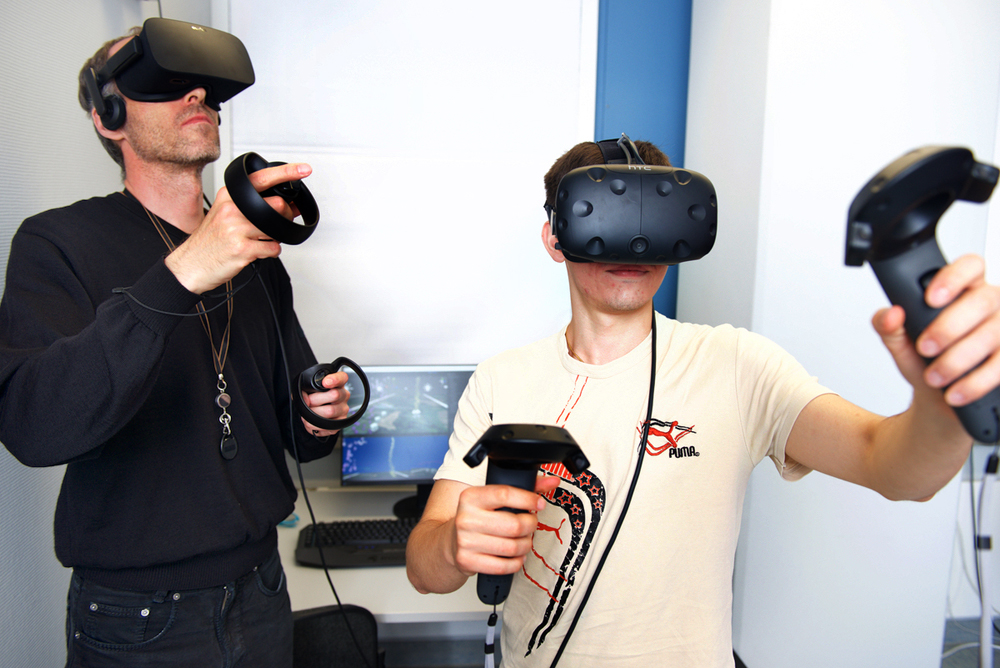D04 | Quantitative Aspects of Immersive Analytics for the Life Sciences
Immersive Analytics (IA) is an emerging field that studies technologies facilitating a deep cognitive, perceptual and/or emotional involvement of humans when understanding and reasoning with data. The goal of this project is to investigate and quantify the impact of such technologies on immersion, and the role of immersion for data analytics. We aim to further develop the Immersive Analytics methodology and investigate the applicability of IA approaches to research tasks in the life sciences, with a particular focus on quantitative aspects of immersive analytics. We will design immersive environments for selected applications of the life sciences and develop new methodologies that allow us to put the human in the loop for an immersive experience during an analytics workflow.
Research Questions
How can we quantify immersion in an analytics process, and how can we quantify the impact of immersion?
How can we best support analytics and decision making tasks with Immersive Analytics approaches facilitated by new technologies?
What are new potentials and benefits that IA brings for tasks in the life sciences, and how can we quantify them?
Publications
- F. Schreiber et al., “Sustainable software development in science – insights from 20 years of Vanted,” Journal of Integrative Bioinformatics, p. 20250007, 2025, doi: 10.1515/jib-2025-0007.
- D. Garkov et al., “Interactive delineation and quantification of anatomical structure with virtual reality,” bioRxiv 2025.06.17.659041, 2025, doi: 10.1101/2025.06.17.659041.
- D. Bienroth et al., “Automated integration of multi-slice spatial transcriptomics data in 2D and 3D using VR-Omics,” Genome Biology, vol. 26, Art. no. 1, 2025, doi: 10.1186/s13059-025-03630-6.
- N. Gröne et al., “Interweaving Mathematics and Art: Drawing Graphs as Celtic Knots and Links with CelticGraph,” IEEE Transactions on Visualization and Computer Graphics, pp. 1–12, 2025, doi: 10.1109/tvcg.2025.3545481.
- S. P. Feyer, B. Pinaud, K. Klein, E. Lein, and F. Schreiber, “Exploring animal behaviour multilayer networks in immersive environments – a conceptual framework,” Journal of Integrative Bioinformatics, vol. 21, Art. no. 3, 2024, doi: 10.1515/jib-2024-0022.
- D. Garkov et al., “Collaborative Problem Solving in Mixed Reality: A Study on Visual Graph Analysis,” arXiv preprint, 2024, doi: 10.48550/arXiv.2412.14776.
- N. Kraus, M. Aichem, K. Klein, E. Lein, A. Jordan, and F. Schreiber, “TIBA: A web application for the visual analysis of temporal occurrences, interactions, and transitions of animal behavior,” PLOS Computational Biology, vol. 20, Art. no. 10, 2024, doi: 10.1371/journal.pcbi.1012425.
- N. Gröne, B. Grüneisen, K. Klein, B. de Bono, T. Czauderna, and F. Schreiber, “Layout of anatomical structures and blood vessels based on the foundational model of anatomy,” Journal of Integrative Bioinformatics, vol. 21, Art. no. 3, 2024, doi: 10.1515/jib-2024-0023.
- Y. Zhang, H. Williams, F. Schreiber, and K. Klein, “Visualising the Invisible : Exploring Approaches for Visual Analysis of Dynamic Airflow in Geographic Environments Using Sensor Data,” in Proceedings of the EuroVis Workshop on Visual Analytics 2024, Eindhoven, 2024. doi: 10.2312/eurova.20241117.
- W. Kerle-Malcharek, S. P. Feyer, F. Schreiber, and K. Klein, “GAV-VR: An Extensible Framework for Graph Analysis and Visualisation in Virtual Reality,” in ICAT-EGVE 2023 - International Conference on Artificial Reality and Telexistence and Eurographics Symposium on Virtual Environments, J.-M. Normand, M. Sugimoto, and V. Sundstedt, Eds., The Eurographics Association, 2023. doi: 10.2312/egve.20231321.
- M. Kern, S. Jaeger-Honz, F. Schreiber, and B. Sommer, “APL@voro—interactive visualization and analysis of cell membrane simulations,” Bioinformatics, vol. 39, Art. no. 2, Feb. 2023, doi: 10.1093/bioinformatics/btad083.
- D. Bienroth et al., “Spatially resolved transcriptomics in immersive environments,” Visual Computing for Industry, Biomedicine, and Art, vol. 5, Art. no. 1, 2022, doi: 10.1186/s42492-021-00098-6.
- Y. Zhang, K. Klein, O. Deussen, T. Gutschlag, and S. Storandt, “Robust Visualization of Trajectory Data,” it - Information Technology, vol. 64, pp. 181–191, 2022, doi: 10.1515/itit-2022-0036.
- F. Schreiber and D. Weiskopf, “Quantitative Visual Computing,” it - Information Technology, vol. 64, pp. 119–120, 2022, doi: 10.1515/itit-2022-0048.
- L. Joos, S. Jaeger-Honz, F. Schreiber, D. A. Keim, and K. Klein, “Visual Comparison of Networks in VR,” IEEE Transactions on Visualization and Computer Graphics, vol. 28, Art. no. 11, 2022, [Online]. Available: https://ieeexplore.ieee.org/document/9873980
- K. Klein, M. Sedlmair, and F. Schreiber, “Immersive Analytics: An Overview,” it - Information Technology, vol. 64, pp. 155–168, 2022, doi: 10.1515/itit-2022-0037.
- D. Garkov, C. Müller, M. Braun, D. Weiskopf, and F. Schreiber, “Research Data Curation in Visualization : Position Paper.” IEEE, pp. 56–65, 2022. doi: 10.1109/beliv57783.2022.00011.
- M. Kraus et al., “Immersive Analytics with Abstract 3D Visualizations: A Survey,” Computer Graphics Forum, 2021, doi: 10.1111/cgf.14430.
- K. Klein, D. Garkov, S. Rütschlin, T. Böttcher, and F. Schreiber, “QSDB—a graphical Quorum Sensing Database,” Database, vol. 2021, Art. no. 2021, Nov. 2021, doi: 10.1093/database/baab058.
- M. Kraus, K. Klein, J. Fuchs, D. A. Keim, F. Schreiber, and M. Sedlmair, “The Value of Immersive Visualization,” IEEE Computer Graphics and Applications (CG&A), vol. 41, Art. no. 4, 2021, doi: 10.1109/MCG.2021.3075258.
- K. Klein, M. Aichem, Y. Zhang, S. Erk, B. Sommer, and F. Schreiber, “TEAMwISE : synchronised immersive environments for exploration and analysis of animal behaviour,” Journal of Visualization, 2021, doi: 10.1007/s12650-021-00746-2.
- K. Klein et al., “Visual analytics of sensor movement data for cheetah behaviour analysis,” Journal of Visualization, 2021, doi: 10.1007/s12650-021-00742-6.
- M. Aichem et al., “Visual exploration of large metabolic models,” Bioinformatics, vol. 37, Art. no. 23, May 2021, doi: 10.1093/bioinformatics/btab335.
- K. Klein et al., “Visual Analytics for Cheetah Behaviour Analysis.,” in VINCI, ACM, 2019, pp. 16:1–16:8. [Online]. Available: http://dblp.uni-trier.de/db/conf/vinci/vinci2019.html#0001JMWHBS19
- B. Sommer et al., “Tiled Stereoscopic 3D Display Wall - Concept, Applications and Evaluation,” Electronic Imaging, vol. 2019, Art. no. 3, 2019, [Online]. Available: https://www.ingentaconnect.com/content/ist/ei/2019/00002019/00000003/art00014
- S. Jaeger et al., “Challenges for Brain Data Analysis in VR Environments,” in 2019 IEEE Pacific Visualization Symposium (PacificVis), 2019, pp. 42–46. [Online]. Available: https://ieeexplore.ieee.org/document/8781584
- K. Klein et al., “Fly with the flock : immersive solutions for animal movement visualization and analytics,” Journal of the Royal Society Interface, vol. 16, Art. no. 153, 2019, doi: 10.1098/rsif.2018.0794.
- K. Klein, M. Aichem, B. Sommer, S. Erk, Y. Zhang, and F. Schreiber, “TEAMwISE: Synchronised Immersive Environments for Exploration and Analysis of Movement Data,” in Proceedings of the ACM Symposium on Visual Information Communication and Interaction (VINCI), ACM, 2019, pp. 9:1–9:5. doi: 10.1145/3356422.3356450.
- M. Ghaffar et al., “3D Modelling and Visualisation of Heterogeneous Cell Membranes in Blender,” in Proceedings of the 11th International Symposium on Visual Information Communication and Interaction, in VINCI ’18. New York, NY, USA: Association for Computing Machinery, 2018, pp. 64–71. doi: 10.1145/3231622.3231639.
- M. Klapperstueck et al., “Contextuwall: Multi-site Collaboration Using Display Walls,” Journal of Visual Languages & Computing, vol. 46, pp. 35–42, 2018, doi: 10.1016/j.jvlc.2017.10.002.
- Y. Zhu et al., “Genome-scale Metabolic Modeling of Responses to Polymyxins in Pseudomonas Aeruginosa,” GigaScience, vol. 7, Art. no. 4, 2018, doi: 10.1093/gigascience/giy021.
- V. Yoghourdjian, T. Dwyer, K. Klein, K. Marriott, and M. Wybrow, “Graph Thumbnails: Identifying and Comparing Multiple Graphs at a Glance,” IEEE Transactions on Visualization and Computer Graphics, vol. 24, Art. no. 12, 2018, [Online]. Available: https://ieeexplore.ieee.org/document/8249874
- M. de Ridder, K. Klein, and J. Kim, “A Review and Outlook on Visual Analytics for Uncertainties in Functional Magnetic Resonance Imaging,” Brain Informatics, vol. 5, Art. no. 2, 2018, doi: 10.1186/s40708-018-0083-0.
- K. Marriott et al., Immersive Analytics, vol. 11190. in Lecture Notes in Computer Science (LNCS), vol. 11190. Springer International Publishing, 2018. doi: 10.1007/978-3-030-01388-2.
- H. T. Nim et al., “Design Considerations for Immersive Analytics of Bird Movements Obtained by Miniaturised GPS Sensors,” in Proceedings of the Eurographics Workshop on Visual Computing for Biology and Medicine (VCBM), Eurographics Association, 2017. doi: 10.2312/vcbm.20171234.
- M. de Ridder, K. Klein, and J. Kim, “Temporaltracks: Visual Analytics for Exploration of 4D fMRI Time-series Coactivation,” in Proceedings of the Computer Graphics International Conference (CGI), X. Mao, D. Thalmann, and M. L. Gavrilova, Eds., ACM, 2017, pp. 13:1–13:6. doi: 10.1145/3095140.3095153.
- T. Chandler et al., “Immersive Analytics.” IEEE, pp. 1–8, Sep. 2015. doi: 10.1109/bdva.2015.7314296.
Project Group A
Models and Measures
Completed
Project Group B
Adaptive Algorithms
Completed
Project Group C
Interaction
Completed
Project Group D
Applications
Completed
FOR SCIENTISTS
Projects
People
Publications
Graduate School
Equal Opportunity
FOR PUPILS
PRESS AND MEDIA
© SFB-TRR 161 | Quantitative Methods for Visual Computing | 2019.









